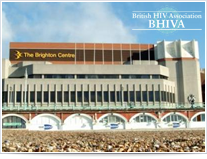Primary HIV infection and early use of ART
1 June 2015. Related: Conference reports, Antiretrovirals, BHIVA 21st Brighton 2015.
Several studies at BHIVA added to the growing evidence from using ART in earlier HIV infection.
This includes specifics reasons linked to treatment during primary HIV infection (PHI) for the diagnosed in this earliest window and also for earlier use in chronic infection.
Definition of timing is essential when looking at these studies.
Immunological benefit from very early treatment persist after ten years ART
A study looking at immune responses in people treated in primary HIV infection (PHI, n=37) compared to starting ART in chronic infection (CHI, n=115) was presented by Colette Smith and from the Royal Free Hospital. [1]
This analysis was conducted after all patients had used ART for at least five years and the results were notably for showing that significant differences persisted even after ten years of ART.
The PHI group started ART within 3 months of infection (median 3 weeks, range 0 to 3 months) compared to the CHI group who started >12 months after diagnosis (median 3 years, range 1 to 14 years). All patients in the CHI started at a CD4 count above 350 cells/mm3.
In the PHI vs CHI groups, median age at diagnosis was 34 vs 32 years; 95% vs 87% were male and 87% vs 73% were MSM.
Median pre-ART viral load was higher for the PHI group: 511,000 (range 3,400 to >10 million) vs 278,000 (range 2500 to >750,000). This would be expected given the earlier samples likely for people diagnosed in early infection. However, median pre-ART nadir CD4 count, CD4% and CD4:CD8 ratio were all similar at ART initiation in each group.
Immune responses to these three markers were significantly better for the PHI vs CHI groups after one, five and ten years of ART. After ten years, median CD4 count was 966 vs 874 cells/mm3 (p=0.02), CD4% was 33% vs 39% (p=0.01) and CD4:CD8 ratio was 1.09 vs 0.85 (p=0.04).
When defining optimal immune reconstitution as achieving one or more criteria of CD4 >800, CD4% >40% or CD4:CD8 ratio >1.0, this was reached after ten years ART by 85% of those treated in PHI vs 53% in CHI (p=0.003).
Some doctors reluctant to discuss early treatment in primary HIV infection
Results from an online survey of more than 200 UK HIV doctors about approaches to ART in primary HIV infection (PHI, <6 months since infection) were presented by Vicki Parsons from UCL.
Although 81% of these doctors had offered ART to at least one PHI patient in the past year (median 2 patients; IQR: 1, 4.5; range 0 to 50), 43% of doctors would not recommend starting ART in PHI for asymptomatic patients when CD4 was <350.and 16% would still not treat if CD4 was confirmed <350 cells/mm3.
Another concern at variance to BHIVA guidelines was that although nearly all doctors (98%) would discuss TasP if their patient was sexually active, only 81% would do this if the patient did not reported sexual partner(s).
Both these later points show aspects of the guidelines that are not being followed consistently.
HIV positive people’s interest in early treatment in PHI
A similar survey from the same group at UCL, this time in HIV positive people, was similarly interesting for highlighting the importance of their doctors advice in using early ART – and therefore the importance of early treatment being discussed.
From July to December 2013, this cross-sectional survey recruited 102 men diagnosed in PHI (half in London) who were enrolled in the UK HIV seroconverters register.
Acceptability of starting ART at diagnosis was high: 69% would have done so if offered, 8 would not and 23 were unsure. Of the 68 who would have started at diagnosis, only 42 (62%) started ART. In contrast, of the 31 who either would not have started or were unsure, 6 (19%) started ART based on their doctor’s advice.
Of the 52 not on ART, 21 (45%) reported their doctor had advised starting ART and 26 (52%) expected to start in the next month. Also, 40 men (83%) would be happy to initiate ART to reduce the chance of transmitting HIV, even if there was no proven individual health benefit.
References:
Unless stated otherwise, all references are to the programme and abstracts from the 21st Annual Conference of the British HIV Association (BHIVA) Brighton, 21–24 April 2015.
- Kinloch S. Enhanced immune reconstitution with initiation of ART at HIV-1 seroconversion (PHI). 21st BHIVA, 21–24 April 2015, Brighton. Oral abstract O7.
http://www.bhiva.org/150423ColetteSmith.aspx (webcast) - Parsons V et al. UK clinicians’ approach to ART in primary HIV infection; comparison with the BHIVA guidelines. 21st BHIVA, 21–24 April 2015, Brighton. Oral abstract O13.
http://www.bhiva.org/150423Julie-Fox.aspx (webcast) - Parsons V et al. Attitudes, beliefs and acceptability towards early ART amongst men who have sex with men (MSM) recruited to a UK cohort of HIV seroconverters. 21st BHIVA, 21–24 April 2015, Brighton. Poster abstract P33.


